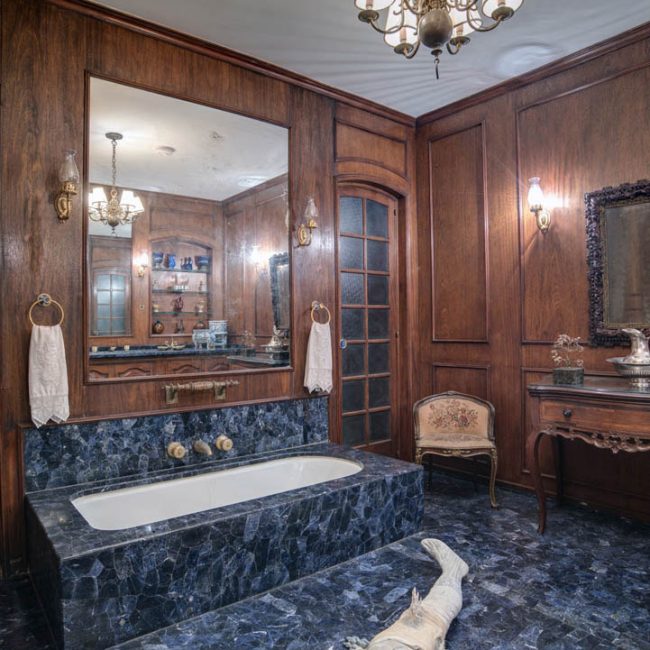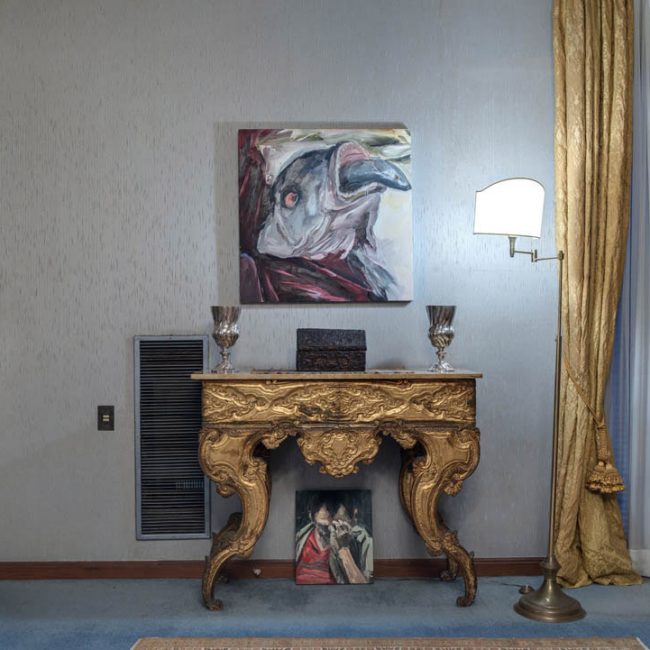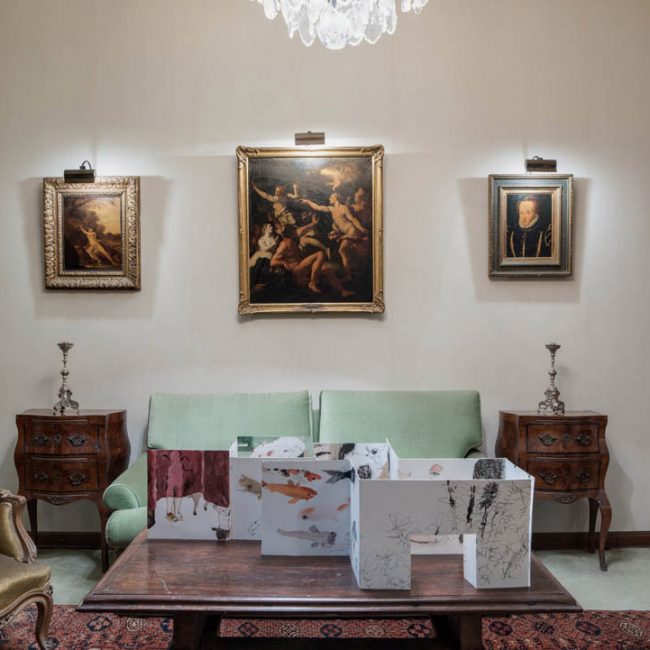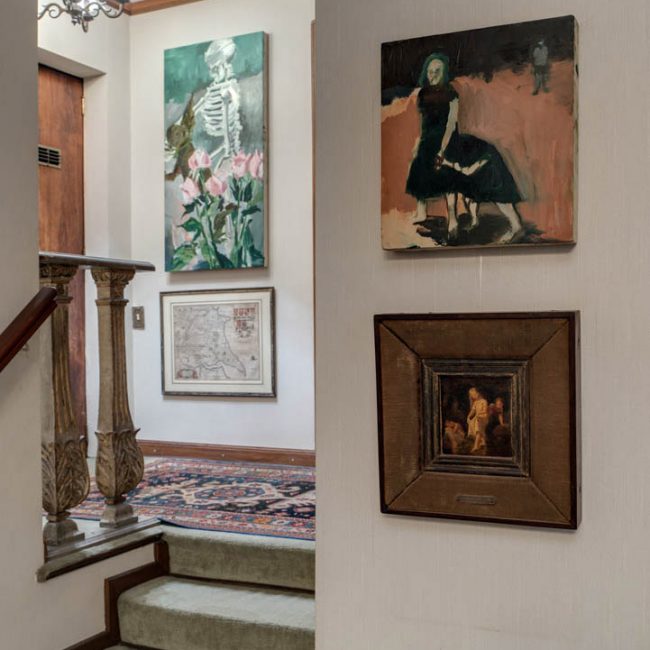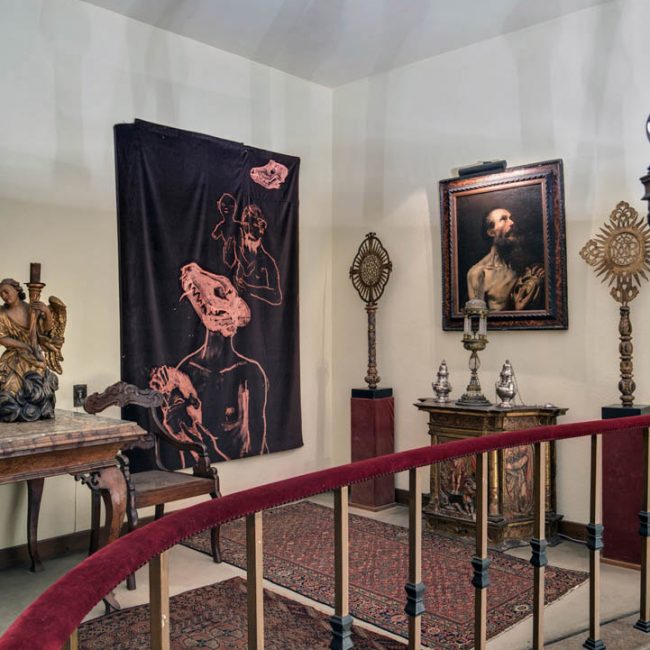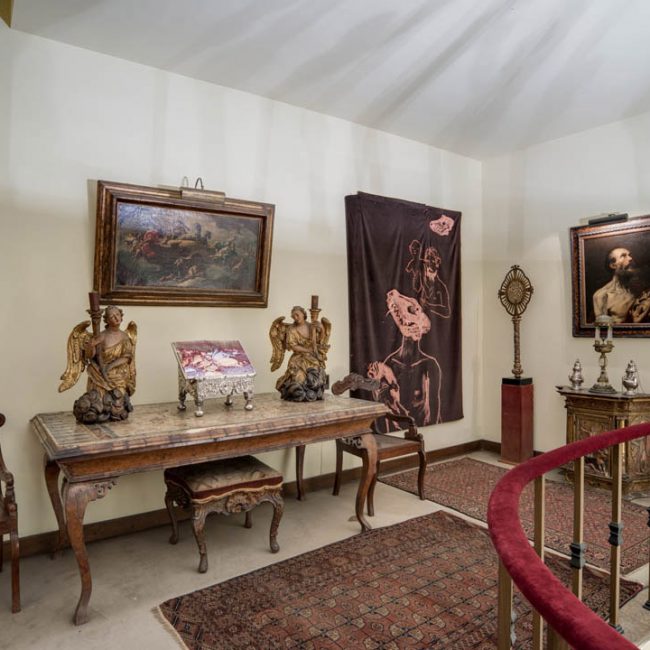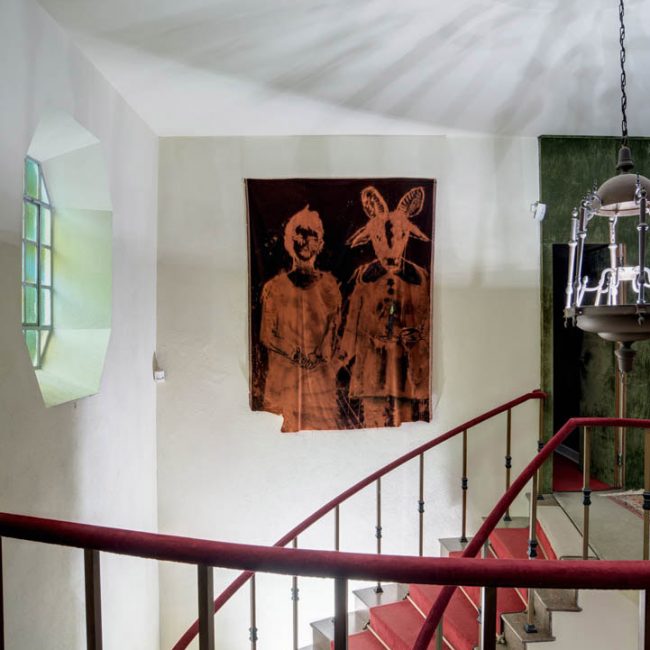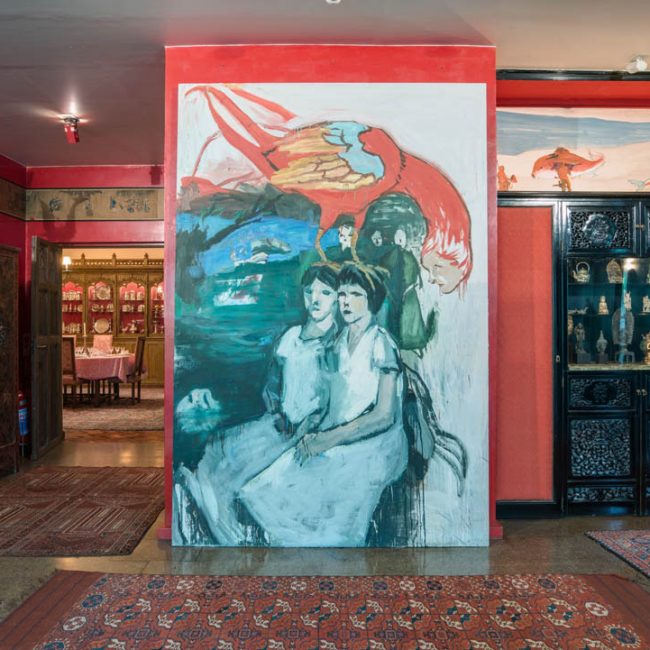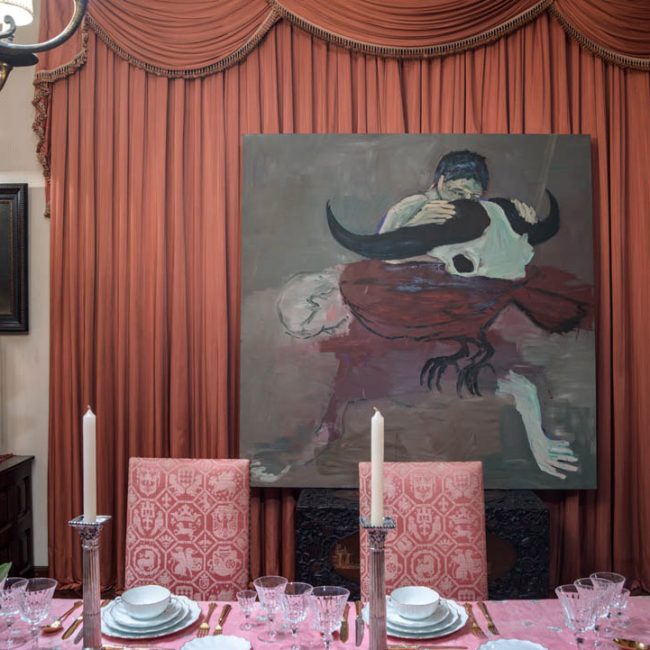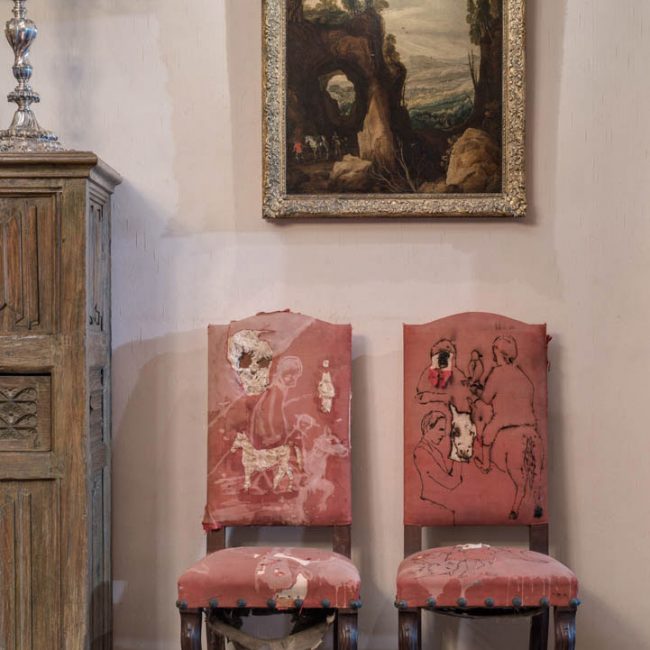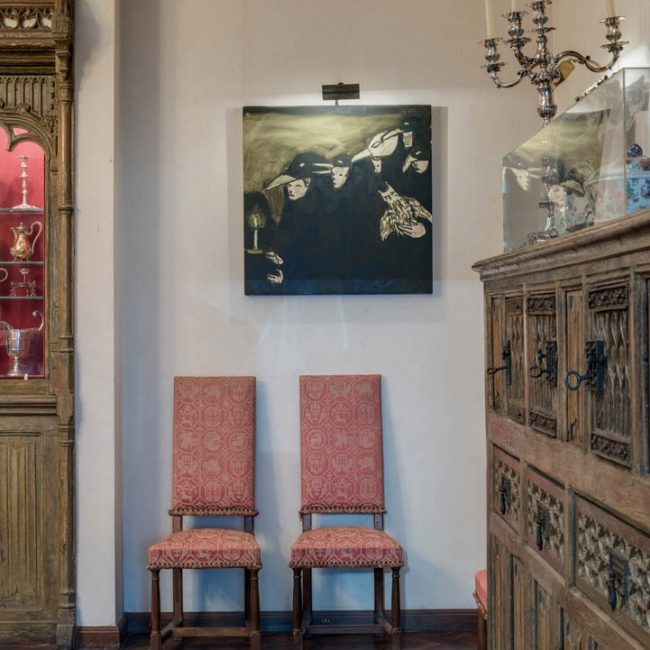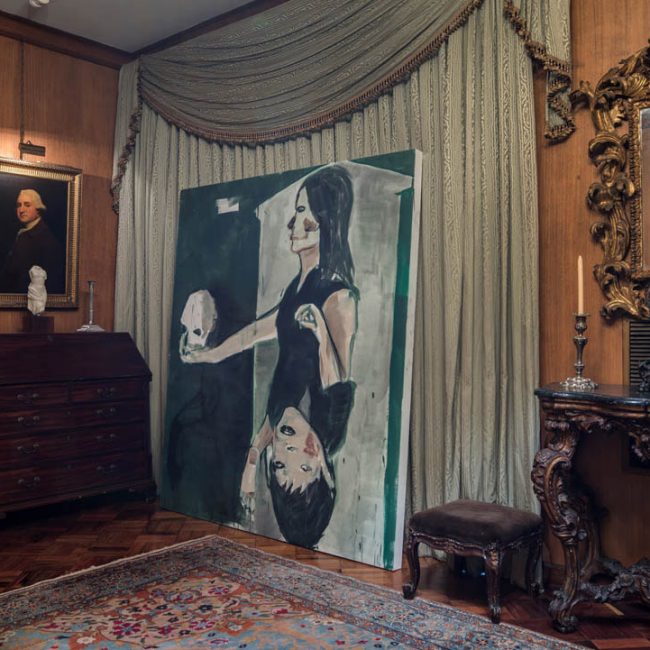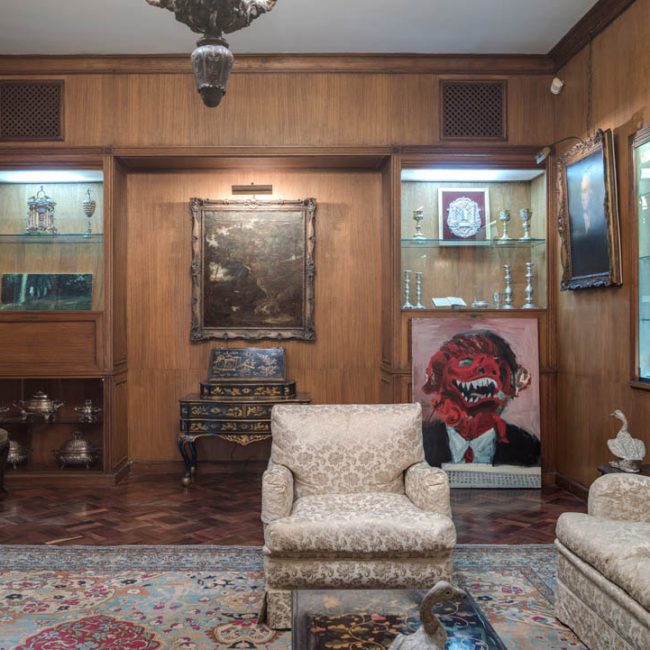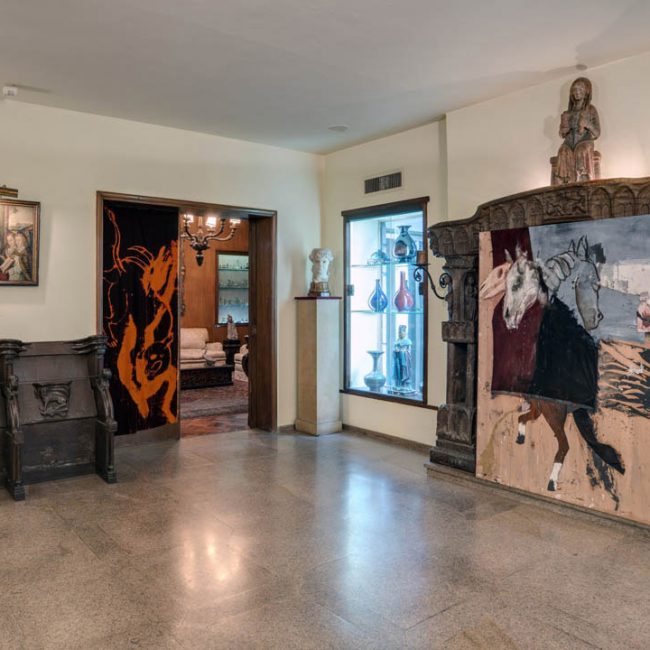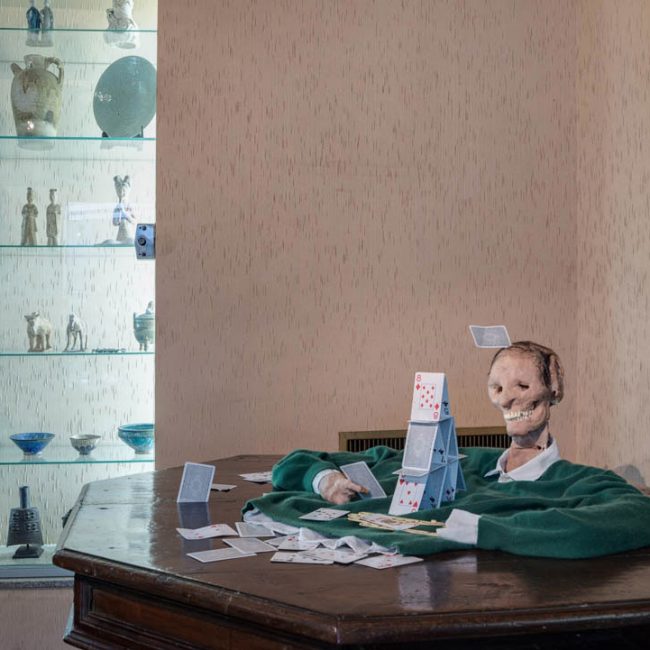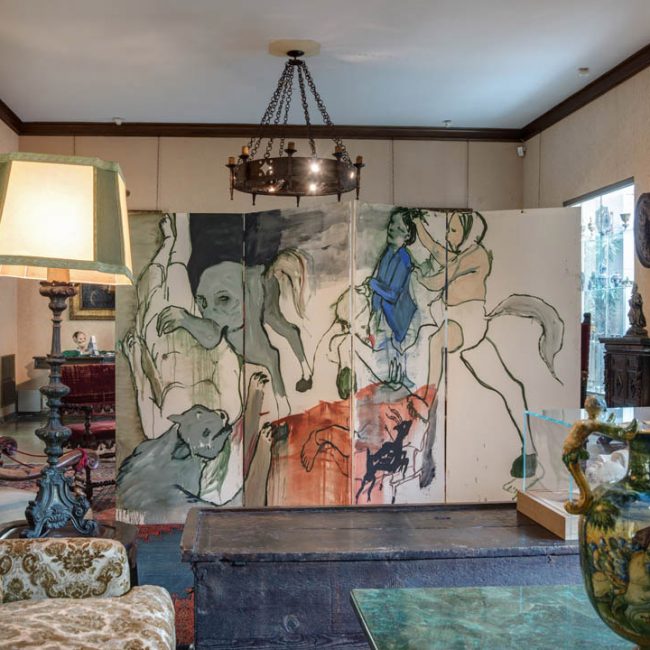Eduardo
Berliner
THE PRESENCE OF ABSENCE
Breathing Project
20th edition | september 10 – november 29 2015
This text was conceptually inspired by “Absence”, an exhibition by Claudia Bakker held at Fundação Medeiros de Almeida, Lisbon, in March 2015
[…] If I were an animal, I would probably be the ink monkey described by Borges in his book of imaginary beings. Like this small creature that drinks the leftover liquid from an inkpot, because of the pleasure I feel when I do calligraphy, I often only stop when the ink from the inkpot has run out. I also identify with the cross between cat and sheep described by Kafka. Friendly and restless, in the eyes of its owner the animal sometimes seems to cry for relief from the butcher’s knife. As if I could carry inside myself the absence of every loss. 1
Eduardo Berliner
Eduardo Berliner is the first painter to be invited to take part in the Breathing Project. It seemed natural to me not to invite painters because as Fundação Eva Klabin is a house museum, its walls are completely filled by the collection, and there is no physical space for more paintings. That it why it became easier to work with installations.
Besides this consideration, there is another underlying intention in the two long-lasting projects I have created – the Breathing Project and the Space for Permanent Installations in Museu do Açude, in Tijuca Forest – which reflects my education under Mário Pedrosa and guides my decisions as a curator. My aim with both these proposals has been the same: to provide continuity for the experience of the post-neoconcrete rupture – the founding moment of contemporary art in Brazil – which, by bringing art and life closer together, breaks away radically from the concept of representation.
How, then, could I invite a painter, for whom representation is still an issue, albeit in a different way? Because of the strong attraction I feel for the quality of Berliner’s painting, which activates my senses, I decided I should follow my intuition. The experience of having a painter take part in the Breathing Project would make an important contribution, while it would also give me a chance to clarify within myself the limits of my own thinking based on the challenge that the potency of his work represents to me, while seeking to bring forth issues of his work that go beyond representation.
Eduardo Berliner works with “collage” in his painting, as Daniela Labra identifies in the first text on the artist from 2008:
The techniques used to compose the works are diverse, from drawing based on detailed observation to collage. Indeed, this latter technique can be seen as a conceptual motif from Berliner’s whole output. Cut-outs are juxtaposed on backgrounds of memories, and these are semi-covered by layers of paint, pencil, other cut-outs, and empty spaces. 2
Labra is right: collage can be seen as the conceptual motif of Berliner’s work. Initially, I saw it as resulting from the proliferation of images in the reality of the digital world, which fosters a confluence of forces of the most diverse of origins, enabling images to be constructed in painting that go beyond the history of this technique, by inserting it at the intersection of different forms of expression and information. To a certain extent, this would replicate one of the concepts of the Breathing Project, which proposes interventions based on the idea of contaminated spaces – spaces that are already charged with different layers of potentially conflicting information, as is Fundação Eva Klabin – a house and a museum – where works from different historical periods coexist in the same rooms, where the absent presence of its founder is preserved, making it into a museum of a life, reviving with each visitor fragments of memory of an existence that was not shared, with its desires, conflicts, doubts, and dreams. Fusions of memories, information, and different areas of knowledge and forms of expression draw the life force of the Breathing Project closer to the “superimposed” images from Berliner’s work, which makes his painting free of any feeling of fetish or nostalgia. 3
However, as I started to spend time with the artist and his extraordinary work, I gradually realized that the origin of the “collage” in his work had a different dynamic and fulfilled a different function, even though it had a visually striking immediacy and even though the artist and those who have written about his painting refer to collage or editing images as a constant in his creative process. But as in all thought processes there are cracks, my reflections gradually seeped into these empty spaces and I started to wonder, à la Merleau-Ponty, whether it was not thanks to the collages, rather than despite them, that we could get in touch not with what they show – what is evident in them – but with what is implicit in this image-fabulation. In other words, I realized I wanted to break the toy apart to see how it worked, revealing the process of how it was made. I believe this procedure will help us to perceive the diagram (to use a Foucaultian expression) that brings the visible and the sayable in Berliner’s work to the surface of understanding. If it is successful, I believe we will perceive that the potency of his work lies in the singular way he addresses “collage”, which is highly revealing of the procedures of art nowadays.
His “collages” are not like the synthetic cubists’ papier collés or Matisse’s collages (they have no aestheticizing concern); they are not a vision of composition by fragments; they are not juxtapositions of images as we see on the screens of computers; nor are they dreamlike or unconscious images like surrealist paintings, although there is some impulse in them that is similar to that of Magritte and Millet, enveloping reality in pregnant silences and suspended states that indicate the void of the presence of absence; or even the painting of Courbet, in his direct apprehension of reality, as Alcino Leite Neto 4 indicates in “A pintura inquietante de Eduardo Berliner” (The unsettling painting of Eduardo Berliner). Berliner’s images are somnambulistic images of a surprising and unsettling reality, which contain all signs of reality. They are sometimes humorous, but often foretell of happenings, as if they were suspended, awaiting a tragic or intimate event yet to come.
Still in my attempt to dismantle the toy to show how it works, I started to reflect about the museum of accidents devised by Paul Virilio, which was designed to bring together records of memories of the different kinds of accidents produced by contemporary society. I believe this reflection may help us consider the issue of “collage” differently. What do I believe the aesthetic of the accident to be? It is the proliferation of images that bombard us daily (attracting and repelling us), facing us with all manner of destruction resulting from violence produced by wars, traffic, personal conflicts, the elements. The common feature of these images is that just as two physical bodies cannot occupy the same space at the same time, the visual result is an image of one physical body being traversed by another.
Let us imagine a car that crashes into a tree. The resulting image is a hybrid structure, part machine, part organic. It is now neither car nor tree, but a third state whose composition is given by the absence of parts of each of the elements that compose it. It is an image where the presence of the absence of parts of the car and parts of the tree is felt by subtraction and not by addition, as takes place in collage. So, we can imagine that these images are the result of hybrid, metamorphosing states, as if a “third nature” was generated whose basis was the materialization of absence.
To clarify the issue, I would like to quote the answer Berliner gave to a question asked by Wang Fang in a 2013 interview for Art World China magazine, when he was asked how he deals with the relationship between human and animal:
Like many children, my first contact with death came through a beloved animal. The dog I considered my own, a great big Brazilian mastiff, got cancer and had to have its hind leg amputated. On the way to the vet’s, my mother tried to explain what had happened, but when I saw the animal I had my first lesson in the gap between oral understanding of a fact and the thing itself. When I saw the great big animal without his hind leg I couldn’t believe my eyes. Looking back, I realize that this was perhaps my first visual experience of the idea of collage. The power of absence and the violence of the cut. Where there had been a leg there was just an area with no fur and a scar drawn with black surgical suture. 5
What draws my attention in this statement is Berliner’s declaration that this was perhaps his first visual experience of the idea of collage and that it is related precisely to the power of absence and not the power of presence. In other words, he sees collage not as being caused by what is added, as in papier collé, for instance, but by what vanishes when one image is intercepted by another; as in a disaster, where the image of the physical world is reconfigured by what has been lost or by the presence of the absence of what came before, creating a polyphony of images that gives expression to the form as metamorphosis.
Another important feature of this statement is his mention of the gap between the oral understanding of a fact and the thing itself. This void is responsible for activating the artist’s creative imagination and huge capacity for fabulation. In fact, there is such a gap, which Foucault presents as the irreducibility of words and things. Images and words do not communicate directly with one another, as we might imagine; one cannot be reduced to the other. They are like two stones that kindle a spark when rubbed together, illuminating reality. So as there is a gap between the world of words and the world of images, what is not said in words is expressed in the things of the world, just as what is silenced by actions and the materiality of the world is expressed in words. Although it is not possible to reduce one to the other, we only perceive the diagram on which reality is supported when we can see through words and manage to read things and their images. This combination is what permeates and what mediates the meaning of a time.
In Berliner’s case, it is the awareness of the untransposability of the sayable and the visible (between oral understanding and the thing itself) that makes him seek out a different visual syntax, whose narrative impregnates the image no longer with the idea of the form as a form, but through a form that is constantly transmuted by metamorphosis. His paintings are guided by a visual perception that seeks to present us with the image in its incompleteness, as we perceive it, for the simple reason that an image always hides what is behind it. Essentially, his paintings do not actually use the traditional artifice of collage, but show us what we really see when we look: one image covering another. By presenting images in this way, he is indicating the untransposibility of words and things. These are pure image-associations that do not let words in to tack together the meaning. Through his painting, he presents the radical nature of the visible, and that is why it has this fantastical appearance.
When I realized that what Eduardo Berlinger wanted to do with painting was to take the visible to radical lengths, I finally understood what it was in his work that attracted me: faced with reality and the real, there can be no retreat, no transcendent metaphysics. This issue is very dear to me in that I believe that the potency of art resides in this fact. That is what the post-neoconcrete rupture brought us. In other words, art is potential; it does not represent anything: it is the expression of reality at its most radical, which is the route that leads towards chaos, the magma that feeds poetry: pure immanent metaphysics.
Fundação Eva Klabin proved fertile ground for Eduardo Berliner in his work for the Breathing Project. The possibility of passing through different times and images meant that he was always discovering new forms, which took shape through the metamorphosis that his eye is capable of constructing, building up a polyphony of images that resonate throughout his intervention. No artist has managed to interact so intensely with the history of the images in the collection. Going round his exhibition means reviewing the multiple details of the collection that normally pass us by. What he presents in these paintings and sculptures is extracted from or emotionally related to the collection or allusions to other works already produced, which are memories awakened by his intense experience with the Fundação Eva Klabin collection. It is incredible to be able to walk around the exhibition in this house through his experience and see how the works are transmuted into new forms that can reveal to us a crushing violence in the simplest of vases or else surprise us with the familiarity of animals, which we realize are scattered around the designs of the carpets, or characters from paintings brought back in a new context.
I could go on at length about how what is “covered” and “revealed” by the artist establishes a polyphonic interaction with the collection, creating a territory of metamorphosis; but I think what matters most is to walk around his intervention mindfully, as he was on his many visits to the foundation, and simply let ourselves see. The greatest power of his work is its capacity to sweep us up and thrust us into direct contact with the rawness of the visible. This direct way of relating the image to the visible holds back anything in representation that would stray from the intensity of chaos, which is what permeates the poetic apprehension of the world and lets us traverse reality and discover that the mystery is transparent – to recall Octavio Paz – and for this very reason it is reality itself manifested. This is why there is no representation, or rather, everything is expression. This is the crux that interests me in art, and Berliner manages to manifest it by creating a visual syntax that does not feel like a tributary of words because, as Daniela Labra indicates to us, he manifests a “[…] conscious will to challenge new possibilities in the difficult practice of returning to painting to be able to touch the world.” And I would add: the difficult task of touching reality through images that bear within themselves the presence of absence.
Marcio Doctors
1 – Interview with Wang Fang published in Art World China, 2013.
2 – LABRA, Daniela. “Colagens”. Wall text for an exhibition at Galeria Durex, São Paulo, in 2008.
3 – LEITE NETO, Alcino. A pintura inquietante de Eduardo Berliner. In: Prêmio CNI SESI Marcantonio Vilaça artes plásticas, 2009/10: mostra itinerante, Brasília, 2011, p. 44-48
4 – Alcino Leite Neto writes that to his surprise, Berliner’s work is not dissimilar to that of Courbet and the eighteenth century realist painters. I agree with him and would add that this proximity denotes that just as the realists were interested in the extremes of the social reality of the people. Berliner is interested in the extremes of visual reality. I develop this idea later.
5 – Interview with Wang Fang. Art World China, 2013.



